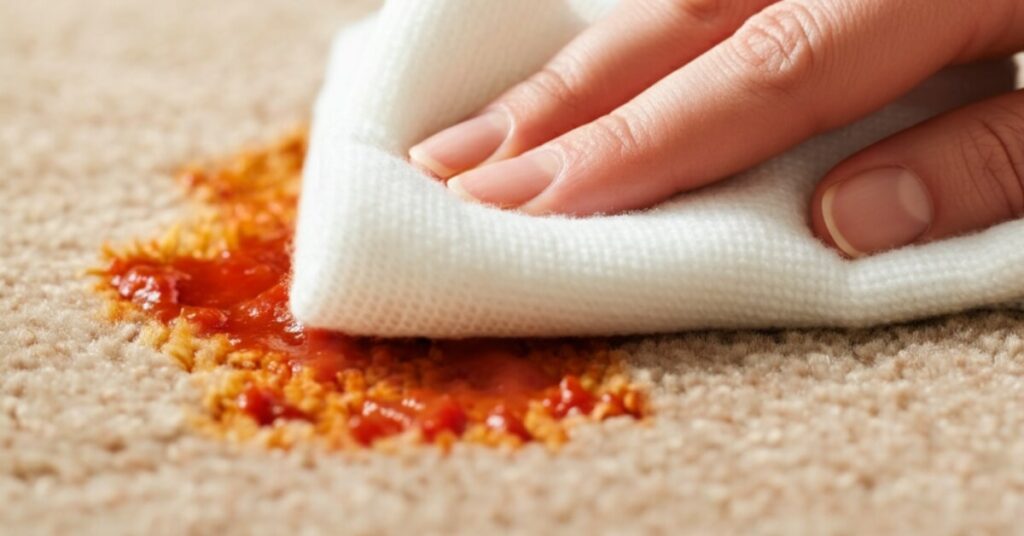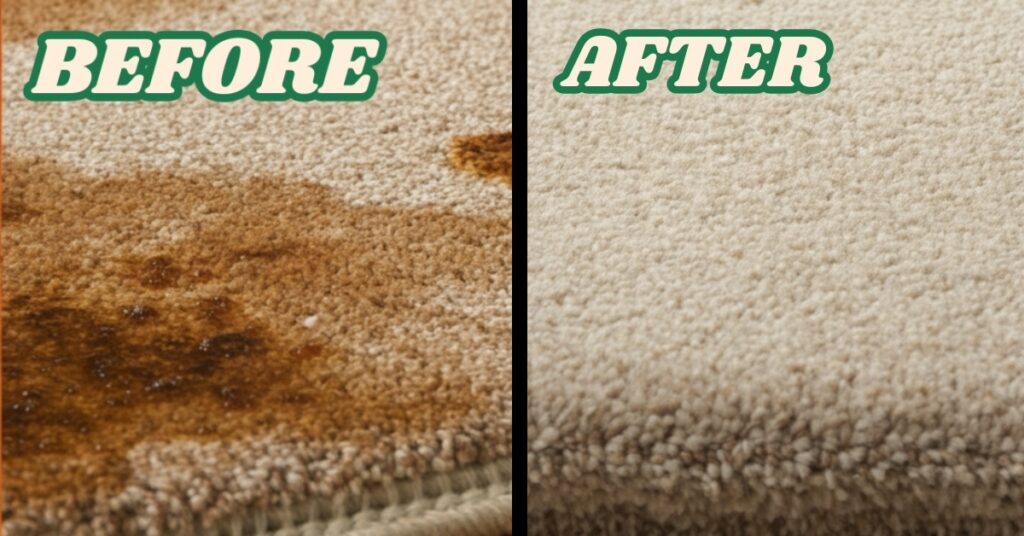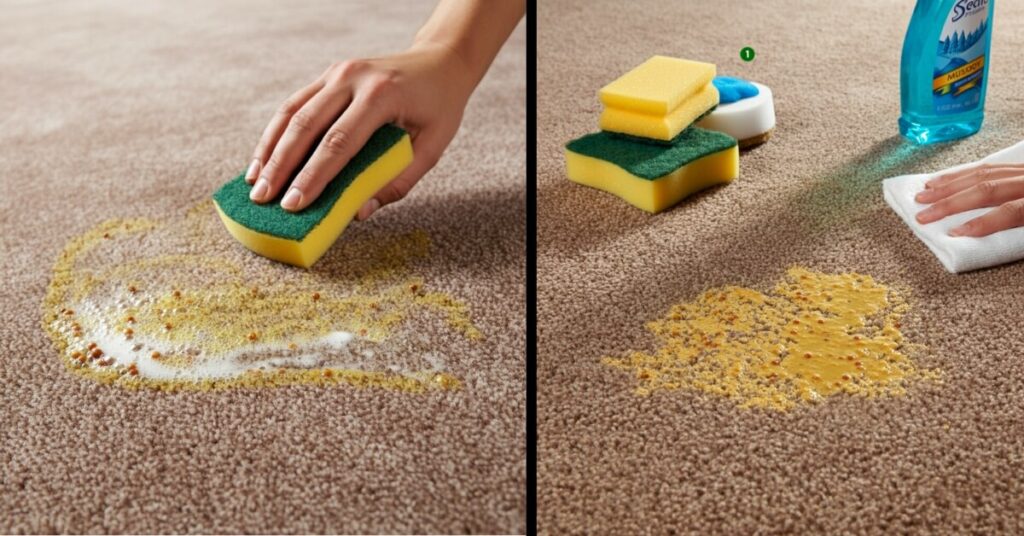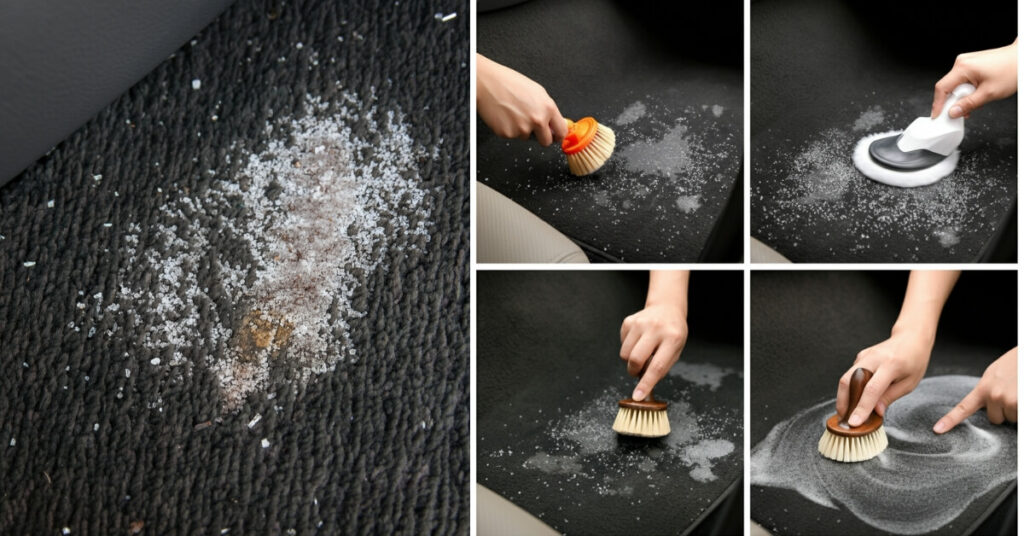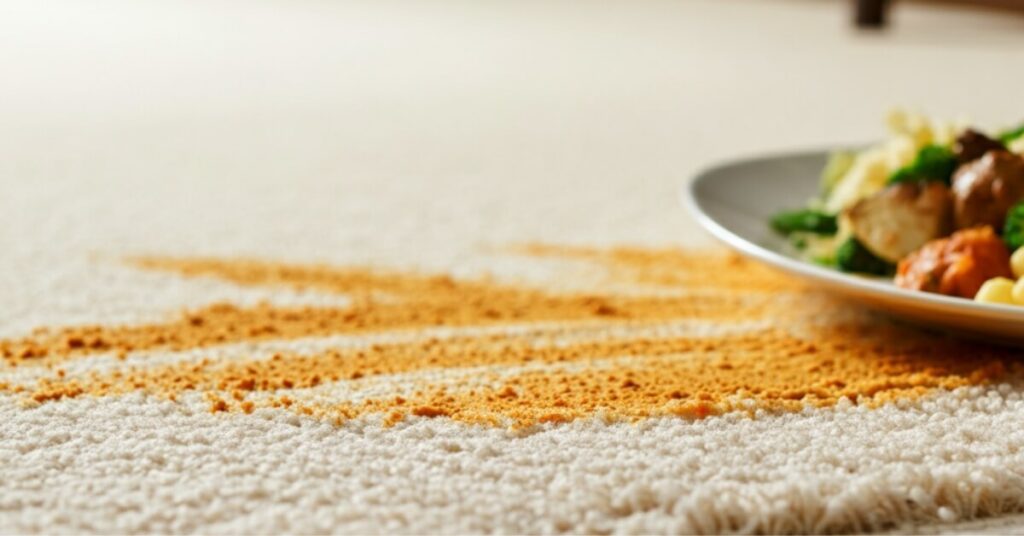As an Amazon Associate, I earn from qualifying purchases.
When a bowl of spaghetti makes an unexpected leap onto your carpet, your heart sinks. The bright red sauce and slippery oil combination creates a stain that looks like it’s here to stay. Maybe your toddler lost a noodle, or takeout slipped off your lap during the big game—either way, it sure feels like a carpet crisis. Don’t panic. With a bit of know-how and a few pantry staples, you’ll quickly learn how to remove spaghetti sauce stains from carpet without reaching for harsh chemicals or spending a fortune.
This easy guide will explain why tomato sauce is so tricky, walk you step-by-step through the stain-fighting process, and highlight tips that stop you from making the stain worse. A splash of time and a pinch of strategy could be all it takes to rescue your rug from ruin—and save your sanity in the process.
Contents Overview
Why Spaghetti Sauce Stains Stick to Carpet and Won’t Budge
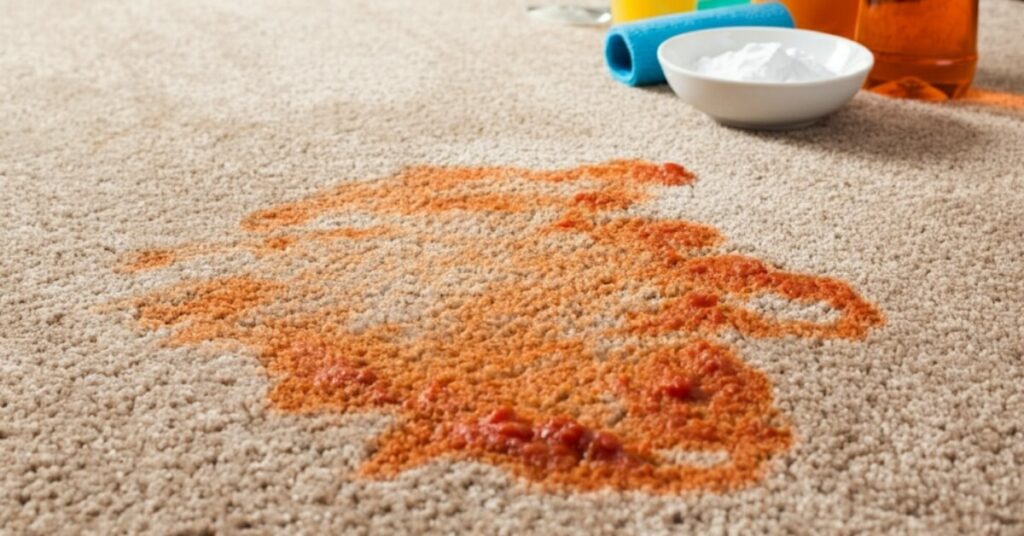
If you’ve ever mopped up a spaghetti sauce spill on the carpet, you know how quickly it turns from dinner to disaster. The reason those red blotches refuse to vanish is all about how those ingredients interact with fibers, not just the eye-popping hue.
Tomatoes, Oils, and Hidden Helpers
Tomatoes crowd the pot with a pigment named lycopene. While it gives sauce that attractive red, lycopene is also a tiny, mischievous permanent cousin to the fabric dye you fear. Once it grabs a carpet fiber, it makes a chemical handshake that simple soap and water can’t break. The stain isn’t just sitting on top; it’s locked in.
Then there’s the oil. Olive oil or canola plays the sidekick, sliding the red pigment deeper and deeper. Because oil is hydrophobic, it turns carpet fibers into tiny water-resistant islands. When you spray your favorite carpet cleaner, it beads up and rolls away, leaving the pigment underneath to party on the carpet pad.
Finally, many store-bought sauces crank up the annoyance with artificial color or spices like turmeric and paprika. Each contributes an extra layer of stain-bonding flavor, ensuring the red blotch you see today is a thoughtful little planner for next week’s cleaning.
Carpet Fibers Drink Sauce Fast
Carpet fibers are like tiny sponges packed together. When anything wet hits them, especially oily or bright-colored liquids, the fibers soak it right in. Wool carpet eats up liquid the fastest, which feels nice underfoot but makes it hard to get rid of stains. Nylon and polyester carpets resist stains a bit better, but they’re not stain-proof.
Once the sauce sinks past the top, it grabs onto the fibers at a tiny, chemical level. This makes it hard to wash out and raises the odds of a shadow stain coming back later, even after cleaning. That’s why you need to deal with the spill right away; every second matters.
How to Get Spaghetti Sauce Stain Out of Carpet (Step-by-Step Method)
Stay calm! No stain is unbeatable. Just follow these easy steps and you’ll give yourself the best shot at wiping it out completely, saving your carpet and your sanity.
1. Move Quickly and Blot Instead of Rubbing
When a tomato sauce spill happens, quick action pays off. Grab a fresh stack of white paper towels or a microfiber cloth and start blotting right away. Press straight down to soak up the sauce without pushing it deeper.
Always blot from the outside of the stain toward the inside, which keeps the color from spreading. Rubbing is a big no-no; it forces the sauce into the carpet fibers and can damage the strands. If the stain is already drying, lightly mist it with cold water before blotting. Just enough to dampen the top—don’t flood it. This brings the sauce back to a fresh, liftable state without smearing.
2. Use Cold Water and Dish Soap
In a bowl, mix one teaspoon of a clear, gentle dish soap with two cups of cold water. Stay away from colored soaps; they can leave another stain. Dampen a clean cloth in the soapy mix, wring it out so it’s wet but not dripping, and carefully dab the stained area. The soapy water breaks up the oily tomato and the color. Cold water is key because heat can set the pigments and bits of protein into the fibers; if those cook in, the stain can become nearly impossible to remove.
3. Blot to Lift the Stain
After you’ve treated the stain with a cleaner, grab a clean, dry towel and blot lightly. Use a gentle press and lift—pressing too hard can push the stain deeper. Switch to a new towel or a dry corner of the same towel after every blot, so you don’t put the stain back on the carpet. This part can take 5 to 10 minutes, so take your time and keep at it.
4. Rinse with Clean Water
Wet a clean sponge with cold water—don’t add soap this time—and dab the area to rinse away any leftover cleaner. Then, blot again with a paper towel until it’s dry. It’s important to get out every bit of soap, because any leftover detergent can attract dirt and leave a dull spot later.
5. Optional: Vinegar or Baking Soda
If the stain is still hanging on, try this: mix equal parts white vinegar and cold water in a spray bottle. Lightly mist the area you just blotted, let it sit for 5 to 10 minutes, and it will help break down any remaining color and cut odors.
If you prefer, you can also sprinkle a good amount of baking soda on the still-damp stain. Baking soda soaks up moisture and smells, and can lift leftover oil and pigment. Let it sit for 15 to 20 minutes, then vacuum it up. For thick carpet, you might need to repeat this step.
6. Repeat, Repeat, Repeat
Patience is crucial when dealing with stubborn spaghetti sauce spills. Don’t hesitate to circle back through the stain-fighting steps as many times as it takes. Just be careful to avoid oversaturating the carpet or scrubbing too hard, or you might fray the fibers or move the stain deeper into the floor.
7. Dry It Out Completely
Let the carpet dry on its own, or boost the process with a fan. For small spots, a hair dryer on the cool setting works fine. Just be sure not to put a rug or piece of furniture over the wet spot until it’s scorched; otherwise, you could end up with mildew.
When the carpet is dry, you can use a clean toothbrush to gently fluff the fibers back up, blending the cleaned spot into the surrounding area. For the better steps, read our guide on how to dry carpet after cleaning.
How to Get Hot Sauce Stains Out of Carpet
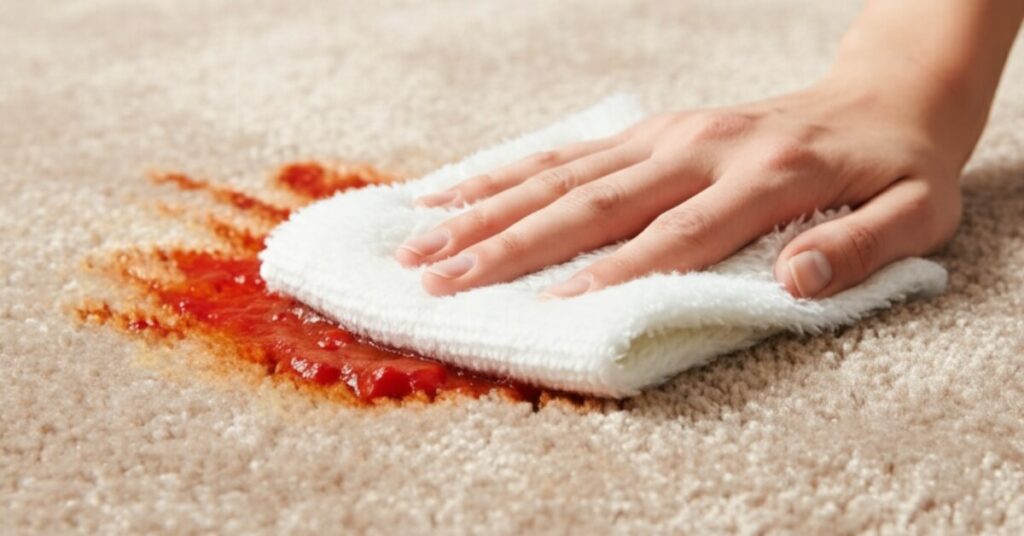
Hot sauce stains create a unique challenge. The bright color, oily base, and punchy spices can turn a small accident into a big mess, but you can still tackle it with a careful plan.
1. Blot Away Extra Sauce Right Away
Immediately upon noticing the spill, grab some dry paper towels and vigorously dab the area. Soaking up the sauce fast helps keep the red stain from sinking in. If the puddle is big, scoop the thick stuff up with a spoon first, then keep blotting until most of the sauce is gone.
2. Reach for an Enzyme Carpet Cleaner
Hot sauce is tricky since it often has pepper mash and other proteins. Regular cleaners struggle with the proteins, but enzyme cleaners break them down. Spray the enzyme cleaner directly on the stain, follow the bottle’s steps, and let it sit. Blot and rinse when the timer dings.
3. Try the Dish Soap Trick
No enzyme cleaner? Mix a tablespoon of dish soap with a cup of cold water, then dab and blot like you would with tomato sauce. The bright pigment in the sauce might take a few rounds, so don’t get discouraged. If the stain is stubborn, stir a tablespoon of white vinegar into the soap mixture. The vinegar helps break down the spicy oils and the red color.
How to Get Tomato Sauce Stain Out of Carpet
Tomato sauce stains are some of the toughest food marks to get out of carpets. They show up as bright orange or deep red blobs and usually come from pizza, ketchup, or pasta sauce. Luckily, you can tackle the stain before it settles in for good.
1. Blot and Isolate the Stain
Start by grabbing a clean, white cloth or a stack of white paper towels. Blot the stain gently, moving from the outside edges toward the center. This technique keeps the stain from spreading and keeps the mess smaller. Keep blotting until the cloth stops picking up color.
2. Try Homemade Solutions
Mix white vinegar and water in a bowl—equal parts of each. Dab the mixture onto the stain and let it sit for about 10 to 15 minutes. After that, blot it up. If vinegar isn’t handy, make a paste from baking soda and water.
Spread the paste on the stain, let it dry, and then gently vacuum or blot it away. Both methods are carpet-friendly and fight the natural acids and bright dyes in tomato sauce. If you’d rather use a store-bought cleaner, pick an oxygen-based, color-safe carpet cleaner. Just remember to test it in a hidden corner of the carpet first to make sure it won’t fade the color.
3. Stay Away From Harsh Chemicals
Skip bleach and ammonia. These can bleach your carpet, weaken the fibers, and blast out fumes you don’t want around kids and pets. Instead, stick with simple home mixtures or gentle store cleaners. They work best on everyday spots without the extra risk.
How to Avoid Setting the Stain (Avoid These Common Mistakes)
To keep your carpet looking new, it’s just as key to steer clear of the wrong moves as it is to treat the stain itself.
1. Never Use Hot Water
You might want to use the hottest water you can find, but fight the urge. Heat makes protein and dye stick like glue to the fibers, and you can’t wash it out after. Stick to cold, or warm at the very most.
2. Don’t Rub, Scrub, or Soak
Pressing hard on the stain can break the carpet’s fibers and create a shadow that you never saw before. Instead of scrubbing, just dab gently with a cloth. Use a small amount of cleaner, and only just enough to moisten. Too much liquid can reach the carpet pad below and cause mold later. Use spray bottles or a cloth that’s just a little damp.
When to Call a Professional
If several cleaning attempts still leave a stain behind, or if it keeps showing up again after the carpet is dry, it might be time to call a pro. Carpet cleaning services use powerful truck-mounted systems, specialized treatments, and trained technicians who can deal with stains that regular cleaning can’t touch. This is especially important for expensive or wall-to-wall carpets, where a DIY approach can sometimes cause more harm than good.
Conclusion
Spaghetti sauce stains can be annoying, but they’re not a lost cause. The key is to move quickly so a small accident doesn’t turn into a long-lasting mark. By blotting instead of scrubbing, using cold water and a gentle dish soap, and trying vinegar and baking soda when needed, you can fight even tough stains with minimal risk to your carpet and your family.
These steps are also great for other tomato-based and greasy spills. Keep a small cleaning kit nearby that includes white cloths, clear dish soap, vinegar, baking soda, and a spray bottle. That way, you’re ready when trouble strikes. And if you still need to call the pros, you’ll be confident you gave it your best shot.
With a little know-how, some patience, and these proven tricks, your carpet will stay fresh and welcoming. A spaghetti spill doesn’t have to ruin your evening—attack the stain right away, follow these easy steps, and you’ll end up with a clean, spot-free carpet. Next time you drop a bowl, you’ll handle the spaghetti sauce stain quickly, completely, and safely.
FAQs
1. Will tomato-based stains come out of light-colored carpet?
Yes, if you act quickly with blotting and cold water, most stains can be removed. Use vinegar or baking soda for tougher spots.
2. Can I use hydrogen peroxide on spaghetti sauce stains?
Yes, but only on colorfast carpets. Test a hidden spot first, then dab and rinse if safe.
3. How long should I leave baking soda on a sauce stain?
Leave it for 15–20 minutes, or overnight for stubborn stains, then vacuum.
4. What if the stain has dried overnight?
Rehydrate the stain with water, then apply dish soap or enzyme cleaner. Repeat as needed.
5. Will a steam cleaner remove sauce stains completely?
Only after initial cleaning and drying. Don’t use steam on fresh stains, as heat sets them.
As an Amazon Associate, I earn from qualifying purchases.
